
Shopping online has made finding iron fence and gate products not traditionally carried in stores much easier. Finding an iron fence or iron gate online is a good start, but how can you tell if it is a quality product? That part becomes a lot harder when all you have to go off of in a lot of cases is some photos and a few bullet points on a web page. Let’s take a deeper dive and go over what you need to look for when buying a quality wrought iron fence or gate.
ITEM #1 – RUST PROTECTION SPECIFICS
The number one concern most folks have about an iron fence is rusting. The problem is that a lot of companies throw out a few vague terms you don’t know and assume you won’t ask questions. Even worst, some sites don’t really specify what type (if any) rust protection they have. Galvanization is a time-honored and great way to protect iron and steel from rust. Lots of fence makers will utilize e-coatings to minimize rust. While they can be effective, it is a thinner coating. We prefer hot-dip galvanization for our parts because it encapsulates every surface of the piece inside and out.
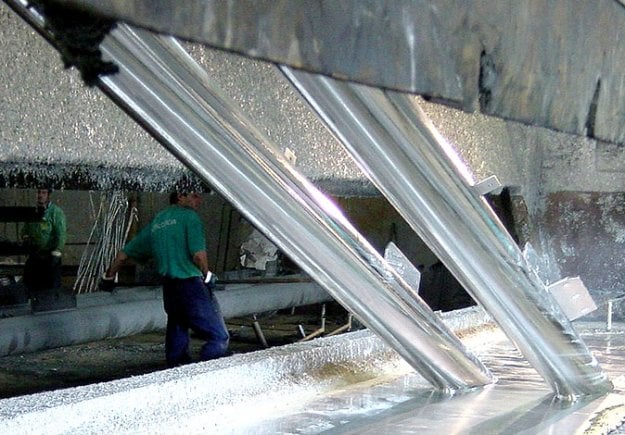
Unlike spray-on rust prevention coatings that only cover exposed surfaces, hot dip galvanization coats the outside, inside and underside of the dipped pieces. The biggest problem with lower end spray coatings is that the pieces will often rot from the inside out and by the time you see it, the piece is already ruined. Look for specifics on how the pieces are treated to prevent rust. Our Stronghold Iron line utilizes a hot dip galvanization, a 4-stage chemical wash and then use a TGIC poly-based powder coating with UV fade inhibitors to protect our pieces.
ITEM #2 – HOW IS IT CONSTRUCTED?
The best construction method for iron fence is one that is strong and looks good from both sides. Below are a couple of photos showing how we build our Stronghold Iron fence with a punched rail and fully welded construction at the picket-to-rail intersection and for the decorative finial tip. You can see the picket (upright) goes through the middle of the punched rail for a strong connection and clean look from both sides of the fence:
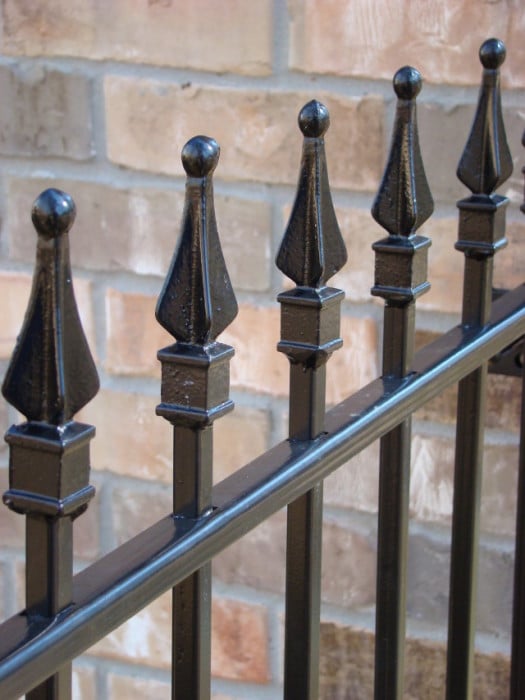
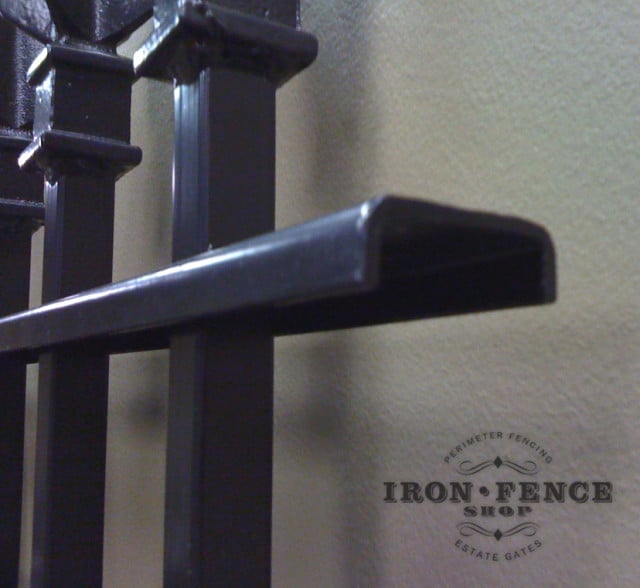
Some steel and iron fence manufacturers will cut corners here. Especially in the rail-to-picket connection (the rail is the horizontal piece and the picket is the upright one). The worst ones we’ve seen is companies using rivets or screws to connect the pickets to the rails. While this works fine on a lighter aluminum fence, it does not work as well on an iron or steel fence. Not only does a weaker connection result in a ‘loose’ feeling panel, but the rivets can allow movement which can scratch down to bare metal and create rust spots.
Another construction shortcut we see is called ‘layover’ or ‘railroad’ construction of pieces. This is where a horizontal rail is laid out and the pickets are welded to the face/ back of the rail. This is not only a weaker way to build the fence that can allow for easier bending of the horizontal rail, but it only looks ok from one side as well. It also looks non-symmetrical and bit unbalanced. Here is an image of a competitor’s piece built in layover style:
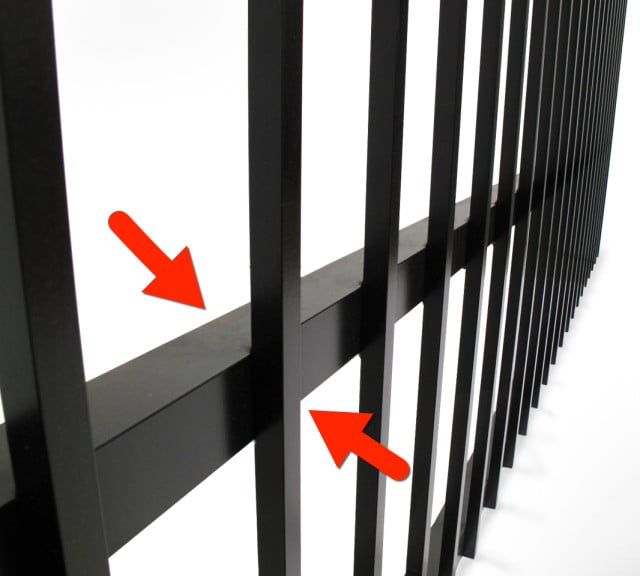
ITEM #3 – FENCE AND GATE HARDWARE
This may seem like a small and unimportant item, but shortcuts here can make a nice iron fence or gate look cheap. Pay attention to the smaller elements like the brackets that connect the iron fence to the posts, the post caps and decorative finials on top of the pickets.
For me, fence brackets is a big one. Nothing makes a nice steel or iron fence go from nice looking to cheap than stamped steel fence brackets. These are made of thin stamped steel and wrap around the fence post to hold the panel up. Below is an image of a competitor’s stamped steel, collar style fence bracket:
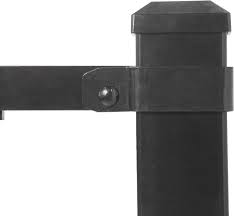
Not the greatest pic, but its tough to find one since the hardware isn’t often shown in detail. These often leave a gap between the rail and post, are tough to get straight, give it a cheaper modular look and draw your eye to them in a not-good way. Counter to that, our Stronghold Iron uses a stronger and cleaner looking cast-iron solid bracket that mounts inline of the fence post. This tucks the hardware and keeps it off the face of the fence line. This gives the look of a more authentic iron fence that was often welded together 100+ years ago. Here are some photos of our standard iron fence bracket:
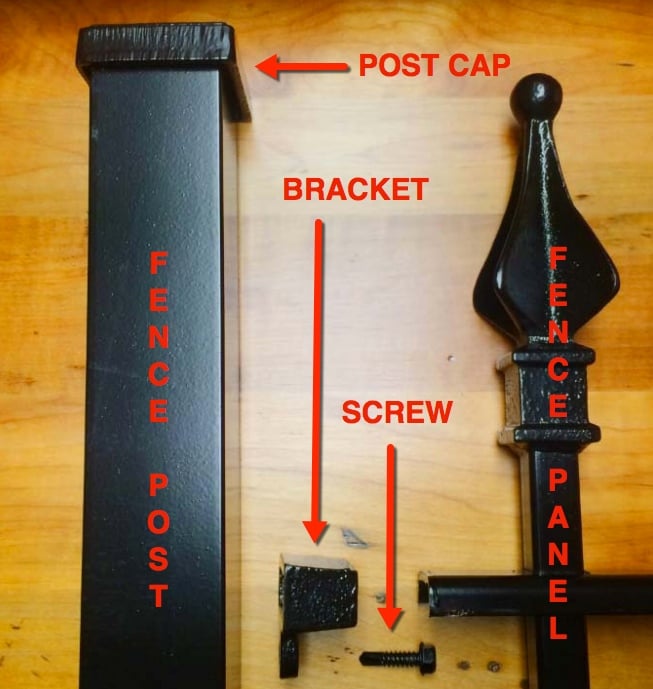
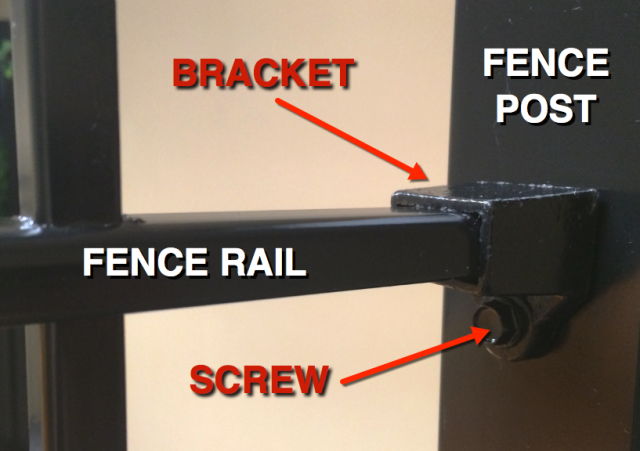
Post caps are another place where cost cuts can be made. Lots of manufacturers will use a stamped steel standard cap which is easier to produce and squish on the top of the post. For the more decorative ball style post caps, some will make them out of aluminum, or worse, plastic. Our Stronghold Iron fence line uses cast iron caps for both styles that you can see in the photos below. The cast iron gives it a nice textured and authentic appearance.
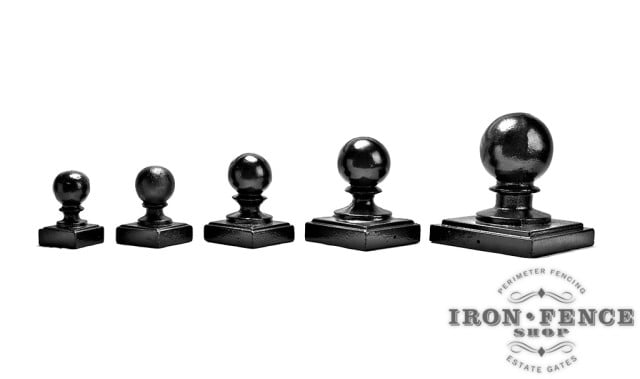
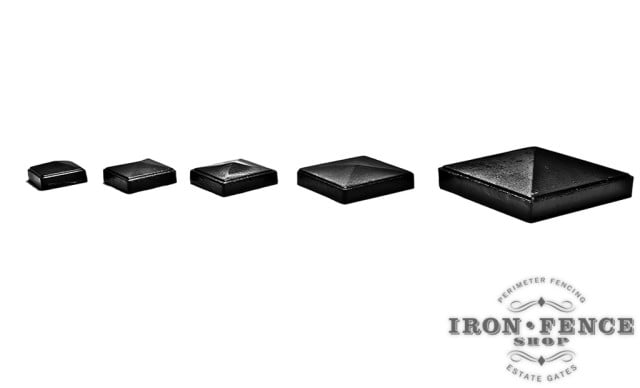
Another place that is tough to tell the quality of the hardware online is those decorative tips on top of the picket called finials. Many places charge a hefty upgrade fee per panel to add finials to the fence panel. The worst part is these are often cheap die-cast, aluminum or plastic that ship loose and you have to glue or press them on. The difference between the fence panel material and finial material will be come apparent over time when the dissimilar metal coatings (or materials like plastic) fade at a different rate and really start to look like a cheap add-on. Be sure to check what those finial tips are made from and how they are attached. Our Stronghold Iron uses solid cast-iron finial tips that are welded directly to the picket like the image below.
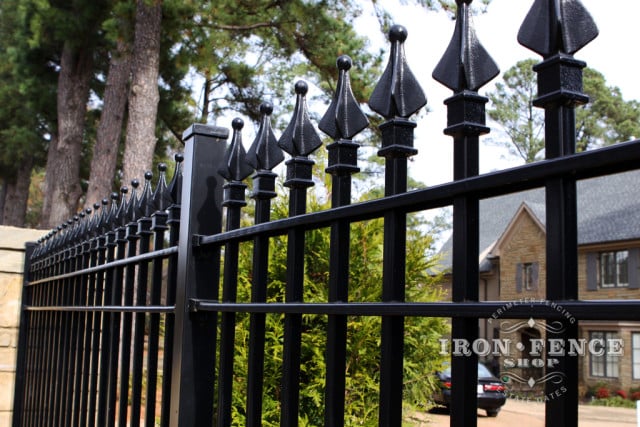
Gate construction is a big one to watch out for too. Unlike a fence panel that is fixed in place and does not move, the gates need to be able to support the weight of the entire leaf as well as any leverage force pressures exerted on them. This is where a proper gate frame comes into play. Many companies will simply weld two posts to the end of a fence section and call it a gate. Functional, but not really all that strong. You will sometimes see cross-bracing on wider gates as a band-aid to poor construction as well. The correct way to make a gate is with a fully boxed and welded gate frame like our Stronghold Iron line. That makes a solid, 3-sided frame that will withstand way more pressure and weight without cracking or deforming. Here is an image showing the U-frame on one of our gates.
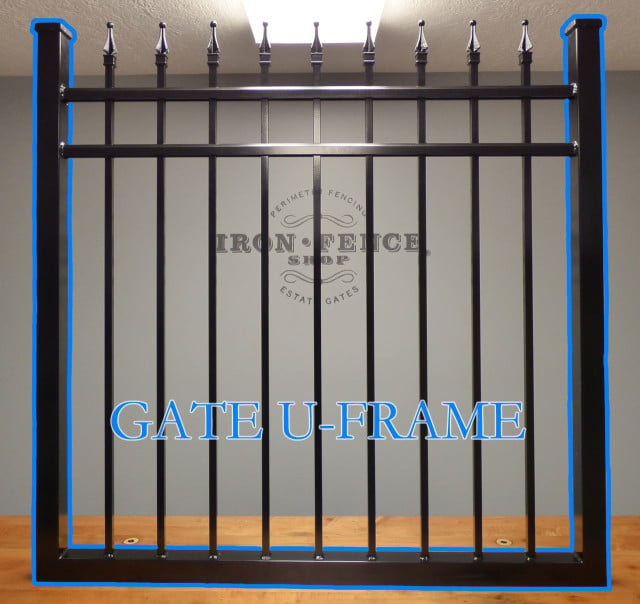
Even little items like the screws and bolts used can be something that makes installation a pain or detracts from the look of the fence. Make sure the hardware is color matched to your pieces and uses a stronger hex-head on the bolts that allow use of a socket. Phillips head style screws can often strip easily and make installation a pain.
ITEM #4 – REAL WORLD IMAGES AND EXAMPLES
Most sites are going to put their best foot forward with the photos on their site. These images have been professionally lit and photoshopped to make the fence look perfect. It gives an idea on the fence’s appearance but doesn’t give a very real world view on how the fence looks installed. Look for a photo gallery of installed jobs on the website to get a better feel how the fence is going to look in the real world. On ironfenceshop.com, I would say 98% of our images in our photo gallery are from homeowner and contractor installations in the real world.
Use these real world pictures to look for examples of the same fence or installation area you are going to be using or your project. How does it look as a whole? Any close-ups of the fence in more detail? Does the fence look weird from certain angles? Things like that. In this day and age, any company worth its salt should have lots of photos and videos showing their products and components. If you can’t find it on the site, is the company responsive to email or phone requests on what you are looking for? You would be surprised how many people are shocked when we actually pick up the phone, answer questions or get back to emails right away.
ITEM #5 – ACCESS TO SPECS
This one isn’t as exciting or as fun as looking at completed fence project photos, but its probably the most important and overlooked item that can make the difference between being an informed shopper and regretting your purchase. Cutting corners on component sizes, thicknesses and finishes is a time honored tradition of lower-end companies that try to undercut higher quality pieces with a lower price. Don’t get me wrong. Price is important, but if you are saving $20 and getting a piece that is half the thickness, weight and will rust in 3 years; are you really getting a good deal? Any fence and gate maker worth their salt will have the ability to provide you specifications (specs) on the pieces you are buying. You can find and download both our abbreviated ‘quick specs’ and our full specs on our specifications page on ironfenceshop.com. Look for something fully versed and thought out like our specs versus some simple bullet points or a short blurb on a web page.
ITEM #6 – WARRANTY INFORMATION
Just like the specs above, you want more than text on a web page about the warranty. While downloading a warranty is a good start (you can find and download ours here), you also want to be able to ask and get good answers on how that warranty is applied. You should be able to talk to someone at the company and ask how warranty claims are handled and what is involved. Just seeing a stated warranty period is not enough to fall back on. Be wary of certain things that can void your warranty (like installing by salt water) or stipulations on what’s covered and what is not (especially on ‘Lifetime’ warranties).
ITEM #7 – THE COMPANY YOU ARE BUYING FROM
Some folks may feel like this is counter-intuitive coming from a company that sells online like we do. However, its more important than ever when dealing with an online sale. Is the company accredited from a source like the Better Business Bureau (BBB) that can give you a good view on customer happiness? We’ve been a long-standing A+ member of the BBB for over 10 years now. If you have a problem with your fence or its delivery, do you have direct access to someone at the company? If you bought your fence through a shopping cart online with no human interaction, good luck getting any issues resolved on that without lots of phone tag and emails.
If you email the company, how quickly do they get back to you? Same goes with a phone call. If you emailed or called and have not heard anything back the same or next day when they are trying to earn your business, how receptive do you think they will be after they have your money? A place where you can get a direct extension and name is going to be much more helpful and receptive than a place with a generic email and no direct people to work with.
————————-
I hope these 7 items give you better understanding on what to look for when buying a wrought iron fence. If I can help with any questions or concerns you have, please don’t hesitate to give us a call at 800-261-2729 or shot us an email at [email protected].
 Free Shipping over $5,000
Free Shipping over $5,000
 15 Years in Business
15 Years in Business
 18mo No Interest Financing
18mo No Interest Financing


